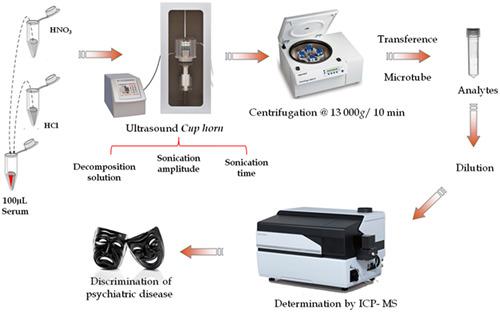当前位置:
X-MOL 学术
›
Rapid Commun. Mass Spectrom.
›
论文详情
Our official English website, www.x-mol.net, welcomes your feedback! (Note: you will need to create a separate account there.)
A feasible strategy based on high ultrasound frequency and mass spectrometry for discriminating individuals diagnosed with bipolar disorder and schizophrenia through ionomic profile.
Rapid Communications in Mass Spectrometry ( IF 2 ) Pub Date : 2020-05-05 , DOI: 10.1002/rcm.8798 Jemmyson Romário de Jesus 1, 2 , Marco Aurélio Zezzi Arruda 1, 2
Rapid Communications in Mass Spectrometry ( IF 2 ) Pub Date : 2020-05-05 , DOI: 10.1002/rcm.8798 Jemmyson Romário de Jesus 1, 2 , Marco Aurélio Zezzi Arruda 1, 2
Affiliation

|
RATIONALE
A viable and accurate method based on high-power ultrasound-assisted microextraction and inductively coupled plasma mass spectrometry was developed to determine metals in human serum from patients with bipolar disorder and schizophrenia.
METHODS
A simple and rapid sample preparation method using a cup-horn sonoreactor was developed. The acid concentration of HNO3 (10, 20, and 40% v/v) and HCl (1, 5, 15, and 30% v/v) of the extraction solution, the sonication time (1, 3, 6, and 10 min), and the sonication amplitude (20, 40, 60, and 80%) were evaluated. Cd, Cu, Fe, Li, Pb, and Zn were determined in serum samples from patients with bipolar disorder and schizophrenia, and from healthy controls. Quantitative metal recoveries using the proposed method were compared under the same conditions using an ultrasonic bath, magnetic stirring, and microwave-assisted digestion.
RESULTS
Optimum extraction conditions were obtained using HNO3 (40% v/v) + HCl (30% v/v) as the extraction solution with 3 min sonication time and 60% sonication amplitude. Significant differences were observed among the methods compared. On application of the sample preparation method based on high-power ultrasound-assisted microextraction coupled with inductively coupled plasma mass spectrometry, Pb and Cd in all the studied samples were below the limit of detection of our method. Compared with healthy controls, the concentration of Cu, Li, Fe, and Zn was found to be significantly higher for the bipolar disorder group, while these metals and Li were found at a lower level for the group diagnosed with schizophrenia.
CONCLUSIONS
Principal component analysis showed a significant separation for the groups studied based on their ionomic profiles after the application of high-power ultrasound-assisted microextraction as a sample preparation strategy.
中文翻译:

一种基于高频率和质谱的可行策略,可通过ionomic谱来区分诊断为躁郁症和精神分裂症的个体。
理由:建立了一种基于大功率超声辅助微萃取和电感耦合等离子体质谱法的可行且准确的方法,用于测定双相情感障碍和精神分裂症患者血清中的金属。方法开发了一种使用杯形角声反应器的简单,快速的样品制备方法。萃取液中HNO3(10%,20%和40%v / v)和HCl(1、5%,15%和30%v / v)的酸浓度,超声处理时间(1、3、6、10分钟),并评估超声振幅(20%,40%,60%和80%)。在患有双相情感障碍和精神分裂症的患者以及健康对照的血清样品中测定了镉,铜,铁,锂,铅和锌。在相同条件下使用超声波浴,磁力搅拌,和微波辅助消化。结果以3分钟的超声处理时间和60%的超声处理振幅,以HNO3(40%v / v)+ HCl(30%v / v)作为提取液,可获得最佳的提取条件。所比较的方法之间观察到显着差异。在基于大功率超声辅助微萃取-电感耦合等离子体质谱联用的样品制备方法的应用中,所有研究样品中的铅和镉均低于我们方法的检测极限。与健康对照组相比,双相情感障碍组的Cu,Li,Fe和Zn浓度显着较高,而诊断为精神分裂症的组中这些金属和Li的水平较低。
更新日期:2020-05-05
中文翻译:

一种基于高频率和质谱的可行策略,可通过ionomic谱来区分诊断为躁郁症和精神分裂症的个体。
理由:建立了一种基于大功率超声辅助微萃取和电感耦合等离子体质谱法的可行且准确的方法,用于测定双相情感障碍和精神分裂症患者血清中的金属。方法开发了一种使用杯形角声反应器的简单,快速的样品制备方法。萃取液中HNO3(10%,20%和40%v / v)和HCl(1、5%,15%和30%v / v)的酸浓度,超声处理时间(1、3、6、10分钟),并评估超声振幅(20%,40%,60%和80%)。在患有双相情感障碍和精神分裂症的患者以及健康对照的血清样品中测定了镉,铜,铁,锂,铅和锌。在相同条件下使用超声波浴,磁力搅拌,和微波辅助消化。结果以3分钟的超声处理时间和60%的超声处理振幅,以HNO3(40%v / v)+ HCl(30%v / v)作为提取液,可获得最佳的提取条件。所比较的方法之间观察到显着差异。在基于大功率超声辅助微萃取-电感耦合等离子体质谱联用的样品制备方法的应用中,所有研究样品中的铅和镉均低于我们方法的检测极限。与健康对照组相比,双相情感障碍组的Cu,Li,Fe和Zn浓度显着较高,而诊断为精神分裂症的组中这些金属和Li的水平较低。



























 京公网安备 11010802027423号
京公网安备 11010802027423号